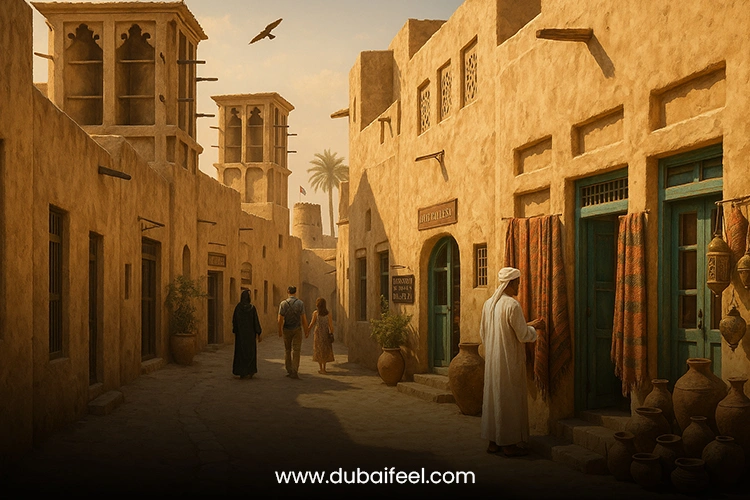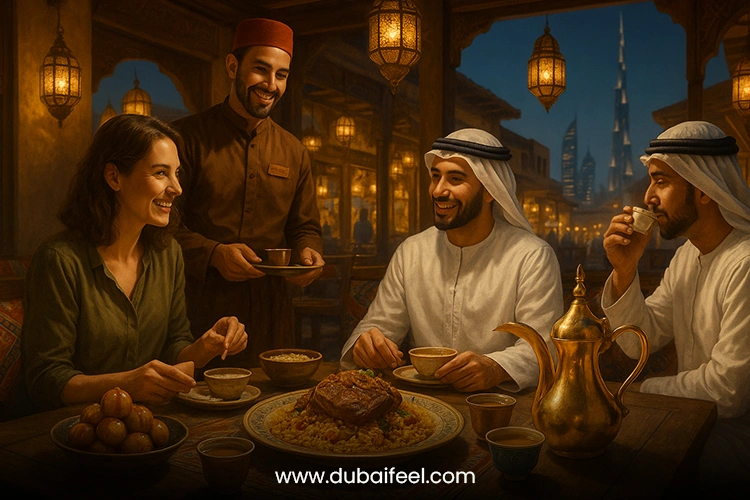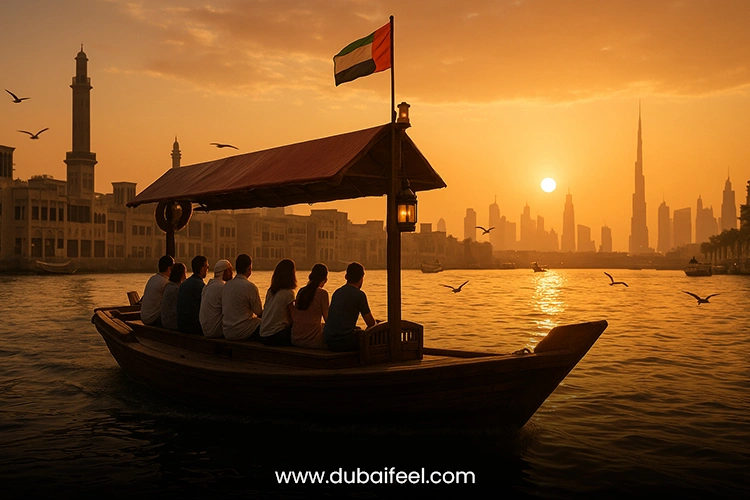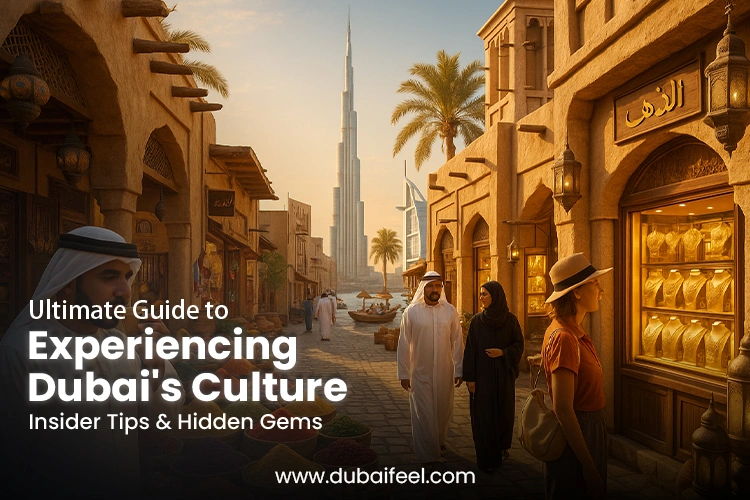Dubai is a city that showcases both modernity and tradition, having areas such as upscale malls and traditional souks, seamlessly fused with one another. The world captures Dubai mainly through its extensive shopping, towering structures, and its glitzy resorts filled with extravagance. However, the city is multifaceted as it has a rich, complex, and vivid local life that is deeply intertwined with its essence. Dubai and its culture are best experienced when one goes beyond the glimmering and polished surface. Along with its modern structures, Dubai is full of traditions and a rich culture.
Finding secluded beaches, hidden within the hustle and bustle of the city, and enjoying local markets filled with traditional Emirati foods, is one of a kind. This is the reason including this guide is essential. It is your ticket to understanding and enjoying the experience of the city as its residents do. The trip is authentic as it is filled with local culture. It eases the traveler to hidden spots of the city that have been calm and untouched. They are then left to enjoy a distinctive intersection of modernity with ancient traditions. No matter the desired experience, this guide is the best resource to showcase Dubai’s most captivating and proper form.
Visit Al Fahidi Historical Neighborhood

For those passionate to learn more about the deep-rooted history of Dubai, Al Fahidi Historical Neighborhood, or Al Bastakiya, is a must-visit. It is located within the boundaries of “Old Dubai”. It gives a mystical experience of the place and its history, even before the imposition of shiny skyscrapers alongside lavish hotels and resorts. The place is a throwback to the zenith of the town’s activity as a minor port where traders from across the globe would frequent, with its narrow winding streets, alleys, and unique style of architecture.
The area is the depiction of traditional Dubai with its narrow alleys and wind towers, relics of a time before there was air conditioning. These towers, along with the uniquely coral stone and gypsum fashioned master pieces of the place, show the wit of the people at that time, form and function as key parts of the architecture, which was meant to serve the environment of the desert. The streets and courtyards alone are enough to understand what life was like during the period when Dubai was at its busiest, in the late 1800s.
As you stroll through, don’t forget the Dubai Museum located in Al Fahidi Fort. This museum shows the development of Dubai from its roots as a fishing settlement to the modern city that it is today. Another essential place to visit is the Sheikh Mohammed Centre for Cultural Understanding, which has the primary aim of fostering tolerance through the sharing of information about Emirati customs, religion, and daily life. Al Fahidi is more than a historical district. It has living demonstrations of Dubai’s cultural diversity, which include boutique galleries and cafes, as well as shops that offer woven textiles and spices.
If you want to escape modern city life, you will find Bal Fahidi the ideal place. This is where the soft sounds of cultural exploration replace the din of vehicles and the mush of people. For an additional experience, visit Bal Fahidi either very early in the morning or in the late afternoon. During these times, the sunlight hitting these historical sites is spectacular, and the overall experience is enhanced.
Appreciate the True Taste of Emirati Culture
Although the world-class restaurants in Dubai are numerous and notable, dining in them is an entirely different experience, especially with an insight into Emirati Cuisine, which holds historic and cultural significance to the region. The food is as traditional and rich as the region, which is adorned with many deep-rooted traditions of blending different spices and exotic herbs with food.
Start your journey of indulging in the rich culture of Dubai with a visit to the Al Fanar Restaurant and Cafe. The Dubai restaurant is known for its confluence of traditional war and peace dishes with a cosmopolitan touch. Dominated by rich, historic spices like cinnamon and saffron, the machboos is a thick rice dish served with your choice of meat. Surely, you will fall in love with the spices the moment you taste the dish. On the other hand, Shut-up is a commonly known street food that is wrapped in soft pita and filled with different kinds of gentle sauces served in Dubai.
Lastly, don’t forget to try Luqaimat, sweet fried dumplings drizzled with date syrup and covered in a veil of sesame seeds. Although the dessert is popular with the masses during festivals and special occasions, it is available in most restaurants throughout the year. The dish is best enjoyed with a cup of Karak tea, another of Dubai’s specialties, which is made with black tea, milk, sugar, and, of course, cardamom. This drink is one of Dubai’s most social drinks and is a must during lunch breaks and dinner time, used to energize the body and lift spirits during the constructive hours of the day.
For a more peaceful and authentic atmosphere, visit the street food markets in the Deira district. Vendors serve a good selection of Dubai’s daily cuisine along with other fresh delicacies. Salona, a hearty and slightly spicy meat and vegetable stew, is quite popular, as is Balaleet, a sweet and spiced egg and vermicelli concoction that boasts the area’s unrivaled love of sweet and salty combinations. The energetic and colorful markets, filled with the exotic scent of spices, result in a more memorable experience than the food itself.
Visit the Spice and Gold Souks

Without question, a visit to the city’s famous Gold and Spice Souks, set in the city’s historic quarter, is part and parcel of the Dubai experience. These vibrant marketplaces provide a window into the diverse cultural heritage intersected with a modern Dubai. Walking in the Spice Souk, one is greeted with the strong scents of frankincense, dried roses, cinnamon, and saffron. The narrow avenues are home to dozens of stall owners with large, colorful baskets filled with different spices, where the client is able to buy anything from turmeric to cardamom, soothing oils to herbal incense, and even therapeutic herbs.
This market goes beyond shopping and offers clientele a complete experience of trading traditions and cultural heritage in Dubai, spanning centuries. Speak to the sellers, who are delighted to tell you the history of their spices and even show you the art of creating a spice blend, often passed down through generations — a true reflection of Dubai’s spice culture. Within a short distance from the Spice Souk is the Gold Souk, a dazzling collection of jewelry shops, each decorated with intricate gold and diamond pieces.
True to its moniker, the ‘City of Gold,’ Dubai’s Gold Souk has everything from ornate gold bangles to beautifully designed necklaces and goldsmiths with the craftsmanship of local artisans, showcasing a deep-rooted culture of jewelry-making. As you walk through the narrow alleyways, the stunning pieces on display will have you entranced as merchants sing out their bargain prices, wishing to partake in the long-standing tradition of haggling — a lively aspect of Dubai’s trading culture.
The Spice Souk and Gold Souk are much more than mere shopping centers. There is a vibrant cultural and architectural charm from Dubai’s old past, which is beautifully on display. As you explore the colorful spice collection or search for the most exotic pieces of jewelry, you will come to an understanding that these are the authentic Dubai cultural experiences that have little to no competition with what modern shopping malls have to offer. These souks are living museums, preserving the culture of trade, craftsmanship, and community interaction that has shaped Dubai into the city it is today.
Ride an Abra Across Dubai Creek

Dubai is known for its traditional wooden boats, known as Abra. Riding the Abra, if you want a break from the outlandish luxury Dubai has to offer, is the most exciting and relatively inexpensive mode of transport. Much of Dubai’s history is also tied to that of Dubai Creek, a “life artery” of the city. As an economic center, Dubai Creek has traditionally represented a meeting place of various cultures, and the Abrah is an enduring symbol of that.
For the nationality, riding an Abrah epitomizes crossing Dubai Creek, and, from that vantage point, you can also gaze at the advanced and ultra-modern Dubai skyline. An Abra ride is enriching and straightforward, and the first thing you notice when you step on the wooden boat is the blast of cool air while you are escaping the suffocating heat of the city. The Abu Creek ride gives you a view of the south of Dubai and lets you know the south is home to historic market areas like Deira.
Deira has spice and gold souks, while the Burj Dubai, Burj Khalifa, and southern Abu Dhabi feature soaring skyscrapers from the other side. There is a sight of Dubai Creek, lush with skyscrapers, colorful, and crowned with the marvel of the world- Dubai Creek. The skylines of the souks are the only region with authentic and world-breath-taking beauty. One is sure to capture the beauty of the skyscrapers with the souks below, and it is the creek, along with the purchase of a ride on an Abra. Floating on an Abra is a right of initiation, a cruise of a lifetime.
Relating to a cruise of a lifetime, there are a few cases to be made that circulating the city on a boat is the most cost-effective method for experiencing the intriguing Dubai. So for the early bird that gets the worm, there is the more meditative, red Elysian light during sunsets, helping to create the perfect, timeless picture.
Unwind at Dubai’s Hidden Beaches
Beach resorts in Dubai are popular, which include private cabanas with infinity pools and five-star service. But, with the intent to understand Dubai like a local, the hidden beaches in the city must be visited. While the tourists enjoy the Jumeirah Beach or the resorts at the Palm Jumeirah, the local population prefers the less commercial beaches with a relaxed atmosphere.
Kite Beach is a perfect example and lies adjacent to Jumeirah Beach Road. It may not be entirely out of the way, but it has a relaxed atmosphere highly valued by the people of Dubai. Locals can be seen jogging and cycling on the beachfront. The beach is famous for its windsurfing and kitesurfing. It is dotted with several locally friendly cafes and restaurants serving nutritious meals to help with a post-swim refreshment to people looking for a quick bite. This relatively secluded part of the coast has stunning views of Burj Al Arab and is ideal for some quiet time away from the crowds.
Another of these lesser-known spots is La Mer, a Jumeirah, which has a lively beach. It has drawn attention in the past few years, but it is still loved by the local population. La Mer beach is a delightful combination of boutique shops of all kinds, and local to global eateries, and, of course, the trendy street art, which has become the hallmark of the area.
Another option is Al Mamzar Beach Park, which provides an escape from the city with its wide-open lawns, picnic areas, and beautiful sand beaches. Al Mamzar is one of the local beaches and is not the most commercialized, which makes it a fantastic alternative if you want stunning views of the Arabian Gulf. Locals go here to relax under the palm trees, go for a swim, or take a stroll around the water.
Experience Coffee Culture in Dubai
The Dubai coffee culture flourishes, and coffee has become part of everyday life and a shared experience that lines the glass towers and soulless offices. Because the world-famous chains have a gob-smacking number of branches across the city, most of the locals prefer the family-run coffee shops, which are more friendly and personal in service. To know Dubai is to appreciate the coffee culture, which goes far deeper and broader than just having a cappuccino.
Ahwa, the coffee drink of the suburbs, is the most sought-after drink. It is the traditional Arabic coffee, made from lightly roasted, arabica beans, sour with aromatic spices like cardamom, and macerated in scalding water. Producing ahwa is a mark of hospitality, a sign of generosity, and, going the extra mile, the dates served with it symbolize it. Ahwa served at traditional coffee venues, like the One Life Kitchen & Cafe or Arabica, is always accompanied by specialty dishes, glamorizing the décor and serving as a perfect prop during conversations or moments of introspection. To drink from a glass is to touch the culture.
Equally important to the street culture of Dubai is the Karak tea, which is sweetened and spiced. Karak tea is different from traditional chai in that it contains sweetened condensed milk and adds cardamom to create a much richer and creamier beverage. It is also more suitable for the warmer temperatures prevalent in Dubai. In Dubai, it is easy to purchase Karak tea either from street vendors in mobile carts and roadside cafes or from more traditional, established cafes. Kiddies and mobile carts are very popular today. Irrespective of the vendor from which it is purchased, Karak is often referred to, even by tourists, as a symbol of hospitality and warmth that Dubai is known for.
This is because the Karak tea, when sipped from a Keddy with coffee, gives the individual the much-needed spice of life in the midst of the bustling city. The tea created with the Keddy creates an experience that transports the individual to a different world.
Just like it is, Karak, the Dubai coffee culture is very modern and globalized with Western influences; coffee culture also possesses local roots and traditions. When this culture is engaged, the sense of community is highlighted, which is less evident when engaging with skyscrapers and the shimmering gold malls. The deep and rich culture of Dubai is available in an easy way, through coffee with every sip.
Contemporary Parks and Vegetation Areas of ‘Dubai’
Among the concrete and glass towers of Dubai lies an urban planner and architect’s dream. Visitors and residents alike are offered a pause from the high-speed lifestyle and whiz of the Emirate city. While Dubai is known for the grandfather of all modern-day couture buildings and an inspiring pace of life, the silent are the parks and gardens which enable the city’s inhabitants to take a break from the buzzing sky-high eloquence.
Al Safa Park is a masterpiece. It is a forty-five-minute walk away from the candle. Al Safa Park is in the vicinity of a few skyscrapers and has an intricate fountain and plenty of trees. Al Safa Park is an ideal escape from city life and is a carefully maintained park, lush with well-tended, flower-filled gardens, and has plenty of seating for visitors. The park reverberates with laughter and pleasant conversations, a gathering ground for not only people but also for all wings. The park is alive, an ecosystem by itself, flocked by sparrows which fill the park with a pleasant melody.
If you would like to enhance your experience with nature, visit the Dubai Miracle Garden, which is a remarkable site with more than 50 million flowers carefully designed into unique shapes and structures. This mesmerizing, seasonal garden is open from November to April. It is a great spot to take a unique picture from every angle. It is a beloved spot for both residents and visitors, showcasing colorful, floral-covered houses and giant heart-shaped arches.
This garden provides a floral immersion experience with its thousands of flower varieties.
One more reason to visit the Miracle Garden is to understand more about Dubai’s effort towards sustainable beauty by turning a part of the desert into a beautiful paradise. It demonstrates how balanced the urban development of the city is in terms of nature-friendly spaces. This part of the city is a testament to how Dubai shares its wonderful, eco-friendly, modern lifestyle with the visitors as well as the residents.
Attend a Local Cultural Event or Festival
To understand Dubai well, you have to attend the many cultural festivals, which are the hallmark of the city. It is one of the most cosmopolitan places. This part of the city certainly provides the best and most authentic experience to understand the special activities from a town that is a wonderful melting pot of customs and modern life.
Located in the Middle of Downtown Dubai, the Dubai Opera is another prime example of how the cities of the world blend arts and distinct forms of culture. Famed for its captivating architecture, the Dubai Opera draws a plethora of world-renowned and indigenous artists alike, for its nightingale organ that hosts the Dubai Opera, ballet, and a variety of contemporary dance and live music performances. From being in the city that never sleeps, one is bound to experience the culture alive in Dubai, from the moment the Dubai Opera is indulged in for its ethereal and magnificent performances, everything a person watches is bound to take them to cloud nine.
Different from the Dubai Opera, another one of Dubai’s favorite performances is the Dubai Shopping Festival, which also occurs every year and floods the whole city with thrilling street performers and significant shopping discounts.
The Dubai Shopping Festival is famous for world-class shopping, but its Dubai culture is also highlighted with the inclusion of authentic Dubai dances, global fashion displays, and art galleries portraying the diverse metropolis culture the city represents. All of the food lovers’ dream, the Dubai Food Festival is a heaven for unique international and local Emirati cuisine lovers, which cultivates the Machboos and Luqaimat with regional and global concepts from Dubai’s recent culinary innovations.
More than these larger pertinent occasions, there are smaller events and community get-togethers that mirror the multiculturality of Dubai. Also, if there’s an art show featuring home-based Emirati artists and a music festival glorifying the region’s rhythms, there are many cultural events in Dubai. Dubai seamlessly infuses these contemporary occasions with traditional cultural displays. Emerging and developing cultures are observed instantaneously, and these are some of the periods when these festivals come in handy.
Conclusion
To fully appreciate the local perspective of the region, there are a plethora of local hidden gems waiting to be explored. Traveling to these places, such as the Al Fahidi Historical Neighborhood, where one can have traditional Emirati dishes, picturesque parklands from where one can experience a sense of calm, and at the festivals and local cultural events, are the things that you are promised to have from Dubai. Skipping paying for the local lifestyle makes one’s trip incomplete. The charm of Dubai rests in the crossroads where ancient traditions, modernization, and sustainability meet. If you would like to be at the epicenter of these and attend thoughtful events, serene parks, or local festivals, Dubai surely makes it worthwhile.

